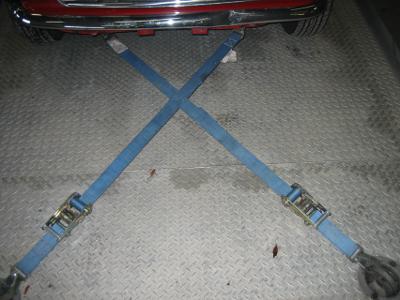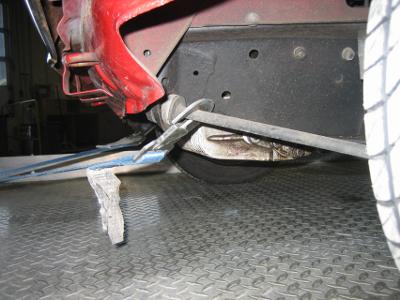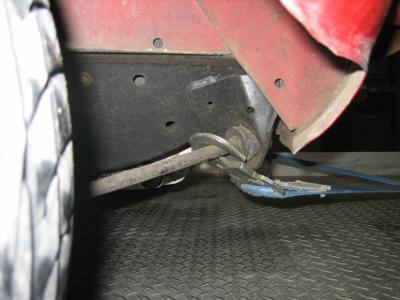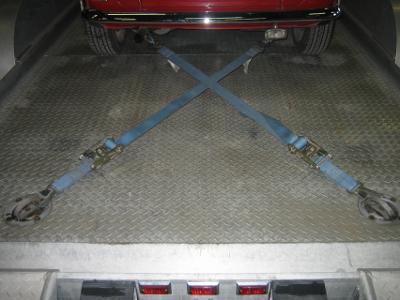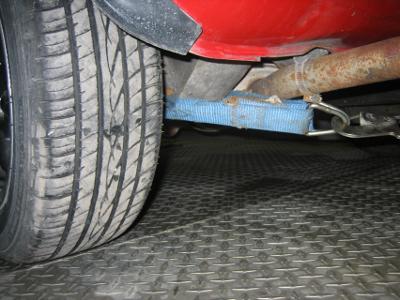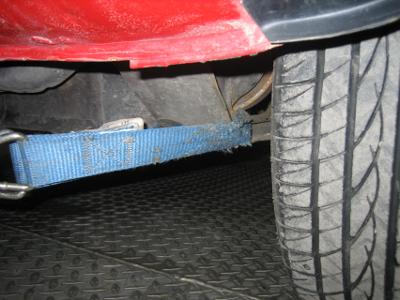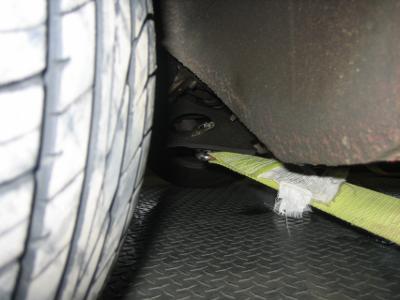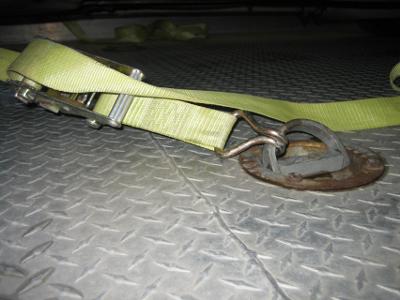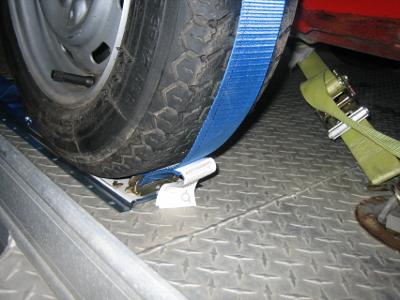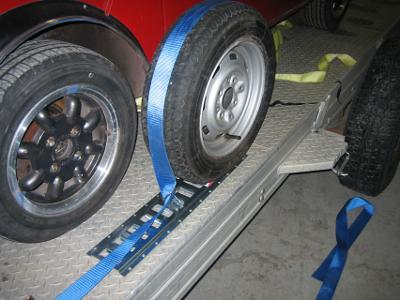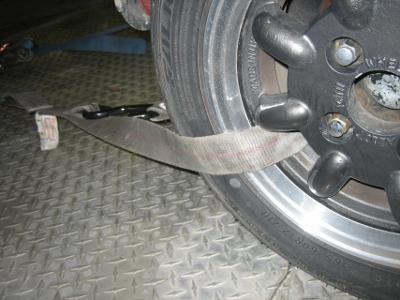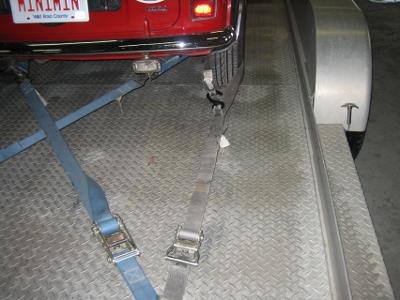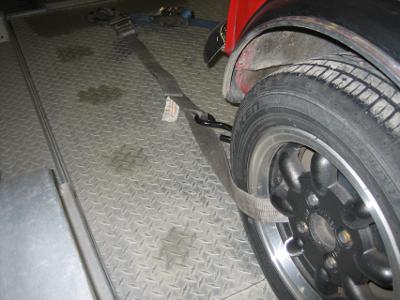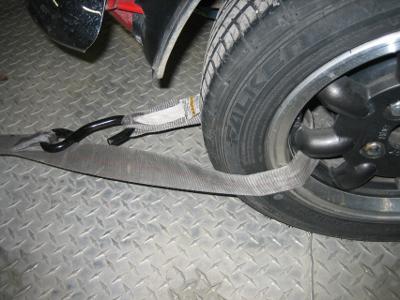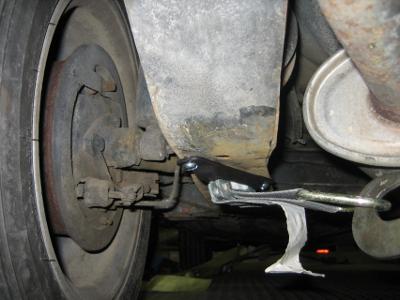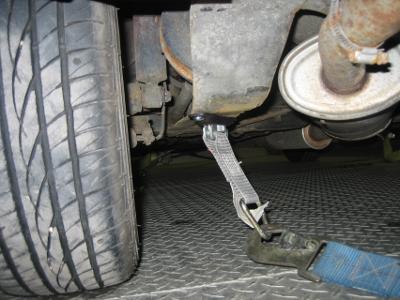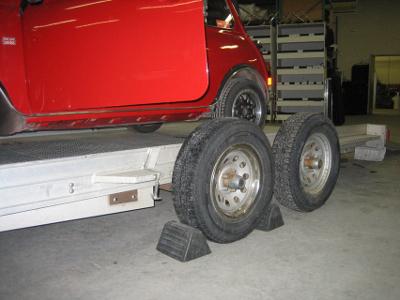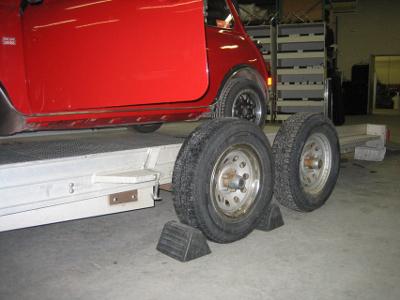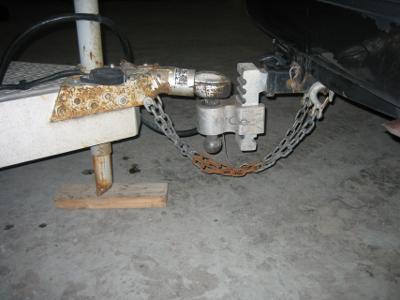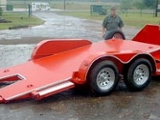How to Tie Your Classic Mini Down to a TrailerWhen you push, pull or drive the mini onto the trailer, step on the brake pedal and firmly apply the parking brake. On some minis, especially project cars that have been sitting for years, both actions may have no appreciable effect. Placing the transmission into a gear might prevent a mini from moving on level ground but won't hold much on an incline. If there is any concern that the car might move while you are fitting straps, have an assistant sit in the car with their foot on the brake, chock the wheels, or have multiple assistants hold the car in place. Minis with Actual tie-down points, front and rear: MK IV minis that came to Canada had excellent recovery/tie down points on both front and rear sub frames. Good quality straps will fit into these points and can go to the tie-down points on the trailer deck. I run my straps in an X across one another, so the load cannot shift from side to side, as might happen if the front and rear straps were parallel. There is no need to over-tighten the straps. I have seen cars tied onto trailers with chain and load binders; hardware suitable for heavy equipment. This sort of gear can leave a car with permanent damage to the frame, body or both. Minis without any tie-down or recovery points: There are a few places you can go here. On the front sub frame I like to place a hook around each lower tie rod at the front mount point, and then cross the car diagonally to make an X. At the rear, I will slide a reinforced axle strap through the openings for the suspension trumpets on either side. This will result in wear to the strap over time, and may also result in the strap being pulled into and becoming stuck between the rubber cone and the steel of the sub frame, where it might be hard to remove it. I have never done this with any of those steel coil spring replacements. As long as the strap is armored and you keep an eye on wear, you should be fine.
On long wheelbase minis such as wagons or vans, the exhaust is usually in the way of running the straps in an X. You can run them parallel, but do watch for movement from side to side. Another excellent place to tie a mini down is the large round hole in the front sub frame behind the axles. You can use this hole to place a hook to go forward or backwards. I use these when loading a mini onto the deck of my 3 ton work truck, mostly as that uses the load control hardware that comes with the truck.
If your trailer has E track mounted to the floor, you can quickly fasten the car by running a strap over the wheels. Wheel bonnets make this an even more secure system. Almost any large population center will have a business that specializes in sewing custom load control for truckers, and these folks will make a set of smaller wheel bonnets that will fit 10" mini wheels and tires. While these may not come with a load rating tag, these are straps that are easily rated for 6000 lbs+. Place the E track strap or E track rope tie-off ahead of the wheel, place a rope tie off behind it, and then fasten the other end of the strap a small amount farther back so that you can fasten the ratchet.
Another system, one used to tie multiple cars onto big trailers, is to run a regular ratchet strap from ahead of the tire at the edge of the trailer, through an axle strap, and then behind the tire, through the strap again, and then to a point behind that wheel and at the rail again. This is another style where a wheel bonnet style tie down can make for fast, secure work.
Straps can sometimes be run through the openings of aluminum or steel rims. This depends on the actual rim. Some wheels will have sharp corners that will cut into the straps. As with any style of fastening the car down, you need to regularly check the wear and tension of all straps. To prevent the strap from polishing the area below it, place a couple of layers of cloth in between the wheel and the strap.
If your mini has the cute little tow loops coming out of the front valance, don't use these for anything. Pretend they are not there since they will break. A later part KPU100160 fitted to injected cars seems beefier. I have not used these and still prefer the lower tie rod. Fitting permanent recovery/tie down points is a must on race cars, and is an OK idea for cars that are frequently towed. Mini Mania Part number 21A1220R looks sharp. A photo here shows a single E-track point bolted to the rear sub frame, and straps or tie-offs can be quickly fitted or removed. These are rated for 4000 lbs of straight pull. There are simple D-ring tie down loops available at hardware or racing supply stores as well.
Regardless of the system you choose, safety is your paramount concern. Always have someone with you when you load a car onto a trailer. Securely chock the wheels before you begin, and place the tow vehicle transmission in Park and fully apply the parking brake. If you are working in rain or other weather, extra caution is advised. Trailer decks can be slippery and sharp. Once you are under way, stop in a safe place in the first half hour and re-check the entire rig: Safety chains, breakaway switch cable, coupler, trailer lights, doors, hood, trunk and any other latches on the car or on the trailer.
Every now and again, crawl under your tow vehicle and make certain the hitch is properly bolted on and the ball is tight.
|


